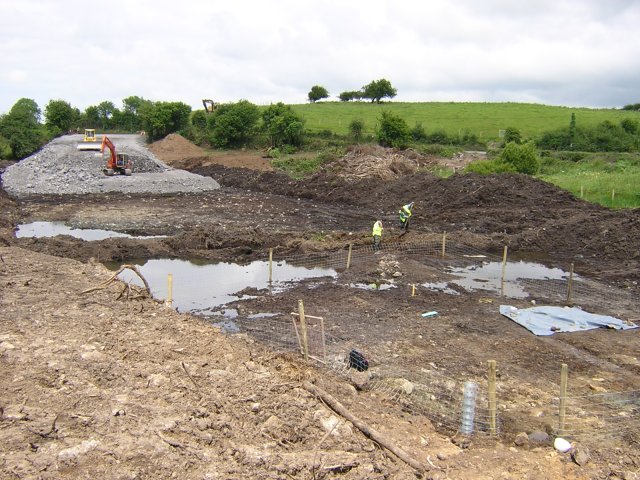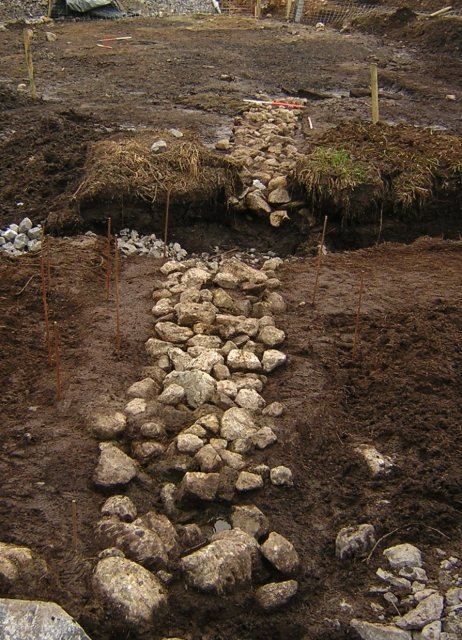Drumaskibbole Fulacht Part 1
Author of original report and Site Director: Tom Rogers
During Construction works for the realignment of the R284 from Drumaskibbole to Ballygawley in County Sligo, Tom Rogers of Moore Group excavated a fulacht fiadh and two stone trackways (along with a number of assorted other features).
Slightly south of Drumaskibbole the road bends sharply, first to the west to avoid the steep slope of a drumlin and then to the east to skirt a small valley. The purpose of the development was to reduce the level of the western edge of the drumlin and to bank up the valley, straightening and levelling the road. At the summit of the drumlin lies Drumaskibbole Enclosure, a ringfort (RMP SL020:124). An initial archaeological assessment of the route, carried out by Mr. Patrick O’Donovan, recommended pre-development testing followed by archaeological monitoring of all ground works. This was carried out by Mrs Anne Carey. Nothing of archaeological significance was found during testing but in the course of monitoring a fulacht fiadh comprising both a burnt spread and wooden trough was uncovered. Slightly to the north of this a line of unbonded stones was uncovered beneath approximately 0.4m of peat.
The excavation was commissioned and funded by Sligo County Council.

Looking North across the site
Excavation work was carried out over a three week period in July 2003. Archaeological monitoring of further areas outside of the area of excavation revealed a second line of stones some 10m to the west and almost parallel to the first. The stones, interpreted as pathways lay over approximately 0.3m of peat, which in turn lay over the burnt spread. The extent of the burnt spread measured approximately 20m from NNW to SSE and 10m from WSW to ENE the trough being off centre, slightly to the east. The trough was recorded and removed. A further generally rougher rectangular trough was uncovered in a pit to the south of the site and a feature comprising laid planks with wattle at the northern end of the site may represent a third.

Stone Path
The townland of Drumaskibbole is situated approximately 5 kilometres to the south of Sligo town and 2.7 kilometres north east of Ballisodare. It is at the southern end of a low lying area which is dominated by Knocknarea mountain to the north west. The subject site lies in a valley just north of the southern slopes of Slieve Dargan and Slieve Daene. All of these mountains boast fine examples of megalithic monuments and any discussion of landscape in relation to the siting of other archaeological features must be mindful of their presence. There is an extensive wooded area to the south and east of Drumaskibbole stretching from Union wood, north of Collooney, across the Sligo mountains to Slish wood on the shores of Lough Gill. As well as Lough Gill 2.5 kilometres to the north east there are a number of smaller lakes and corries in the area including Ballygawley lake 1.4 kilometres to the south which contains an RMP listed crannog. Sligo Bay lies 6 kilometres to the north and Ballisodare Bay lies 3 kilometres to the southwest.
The townland is recorded on William Larkin’s map of Sligo, published in 1819 for the Grand Jury, as Dromiskeybole. It appears on the Barony map under the same name and in the Barony Cess Book as Dromscobbole. It appears in the Map of Coy. of Sligo as D’Sgiboyle and is referenced in the Down Survey of 1656 under Dromsgiboyle and Russin or Russim.
The small valley in which the excavation took place was formed by the deposition of hillocks or drumlins of unsorted glacial material on all sides apart from the north west where the ground drops gently away. Inevitably water was to drain through the valley to the north west.
At the north of the site there was a considerable depth of peat in a localised strip. To the north the peat deposit was shallower and to the south it was present beneath the burnt mound but only to a depth of 0.15m. The likely conclusion is that a gulley running east-west formerly existed here perhaps eroded by the action of meltwater or subsequent fluvial action. When the formation of bog began, perhaps due to a natural damming of the water or flooding of the valley in wetter conditions, the gulley was filled with peat. This event may correspond to the climatic deterioration between 2000 BC and 2500 BC when bogs began to form extensively in the uplands (Mitchell and Ryan 2001, 203). The lower context recorded on the site C35 was sandy but homogenous, while the upper layer (which lay stratigraphically above the burnt mound), was interbedded with sand and marl. This implies an environment prone to high energy events such as periodic flooding.
It is therefore clear that before the first known phase of human activity at this site, peat had already begun to form. Once the peat had been removed, a clear dip was visible in the northern edge of the burnt mound and this is interpreted as the fossilised edge of this gulley. Although it seems that the troughs were situated slightly away from the peat formation, it seems that the burnt stones were thrown down the slope towards the water. This may have been a deliberate attempt at producing a hard platform from which to access the open water or to cross the marsh.
The combination of standing water or a marshy place and abundant stones in a relatively sheltered environment attracted human activity in the Bronze Age. The controversy regarding the actual function of a Fulacht fiadh has been discussed in this blog but is too extensive to be dealt with here. It is known, however, that from about 1800 BC, wooden troughs were built near watery places, perhaps where they may have been replenished naturally with water from the ground and that water within the trough was heated using stones taken from a fire. Constant re-use and discarding of the burnt and shattered stones formed large mounds around the trough and it is clear that these were sites that were used many times over, sometimes as in this case with more than one trough. Often an area of burning is found where the fire was lit to heat the stones.
In Part 2 we’ll go into a little more detail on the sites.
This entry was posted on Friday, April 10th, 2009 at 4:50 pm. It is filed under About Archaeology, Papers & Reports and tagged with archaeological consultants, Drumaskibbole, excavation, excavation report summary, Fulacht fiadh, irish archaeology, pathways, sligo.
You can follow any responses to this entry through the RSS 2.0 feed.





[…] the other hand we have observed here before that in Ireland, what with so much work having been driven by road construction for which there is as of recently no money, digging has almost stopped for the time being; an […]